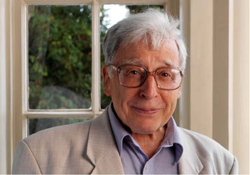The development of in vitro fertilization
The 2010 Nobel Prize in Medicine or Physiology was awarded to Robert G. Edwards for his pioneering work in the field of in vitro fertilisation (IVF), which he guided from basic research through to established clinical usage.
Edwards was first inspired to investigate human fertilisation while working on mouse embryos during his PhD. His research showed female mice could be injected with hormones to make them produce several mature eggs at once, and after conception, developing embryos could be transferred from one mouse to another and still produce healthy offspring. Other scientists had found that rabbit eggs could be fertilised with sperm in test tubes, and then returned to the body to produce healthy offspring. Edwards thought a technique like this, allowing egg and sperm to meet outside of the body, could be used to treat human infertility, which affects around 10% of the population.
 Edwards began his basic research into human conception in the 1950s, making several key discoveries about human fertilisation that helped him to fertilise a human egg in a test tube for the first time in 1969. The egg did not develop past the one-cell stage, so Edwards began working with Patrick Steptoe to refine the technique. By assessing the maturity of eggs before removing them from the ovaries, and measuring patients’ hormone levels to determine the optimum time for fertilisation, the pair made great improvements.
Edwards began his basic research into human conception in the 1950s, making several key discoveries about human fertilisation that helped him to fertilise a human egg in a test tube for the first time in 1969. The egg did not develop past the one-cell stage, so Edwards began working with Patrick Steptoe to refine the technique. By assessing the maturity of eggs before removing them from the ovaries, and measuring patients’ hormone levels to determine the optimum time for fertilisation, the pair made great improvements.
In 1977, Edwards and Steptoe treated Lesley and John Brown, and on the 27 July 1978, a healthy Louise Brown became the first child to be born as the result of IVF. Following this success, Edwards and Steptoe opened the world’s first IVF clinic, Cambridge’s Bourn Hall, where Edwards worked until his retirement, treating couples who had trouble conceiving and further refining the IVF method.
Thanks to Robert G. Edwards’ work, IVF is now an established, safe, and effective treatment for infertility, which has made the birth of over 4 million children possible.
Further reading
http://www.nobelprize.org/nobel_prizes/medicine/laureates/2010/popular-medicineprize2010.pdf
http://www.plosbiology.org/article/info%3Adoi%2F10.1371%2Fjournal.pbio.1001582
http://www.telegraph.co.uk/news/obituaries/medicine-obituaries/9984988/Professor-Sir-Robert-Edwards.html
Last edited: 27 August 2014 05:58
